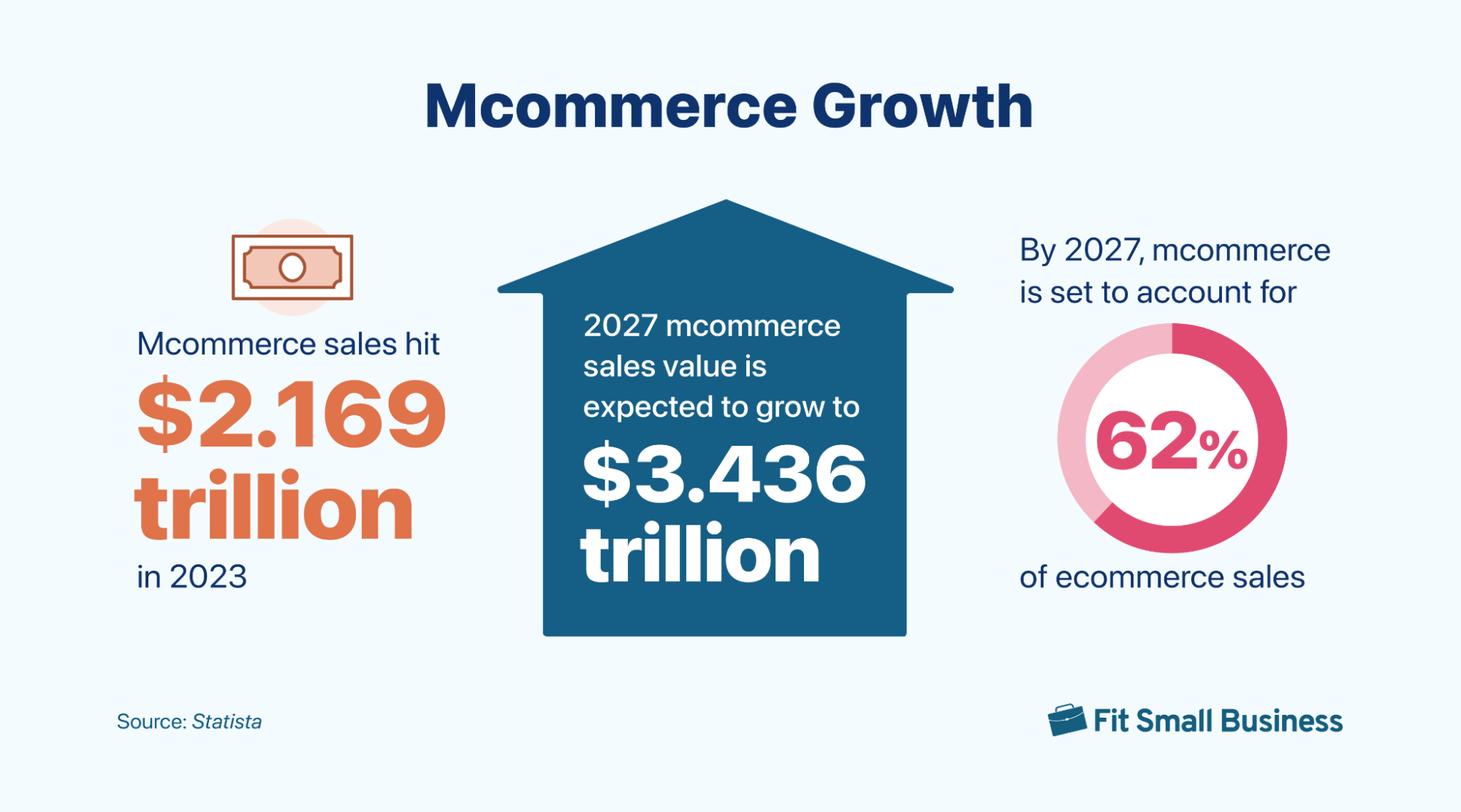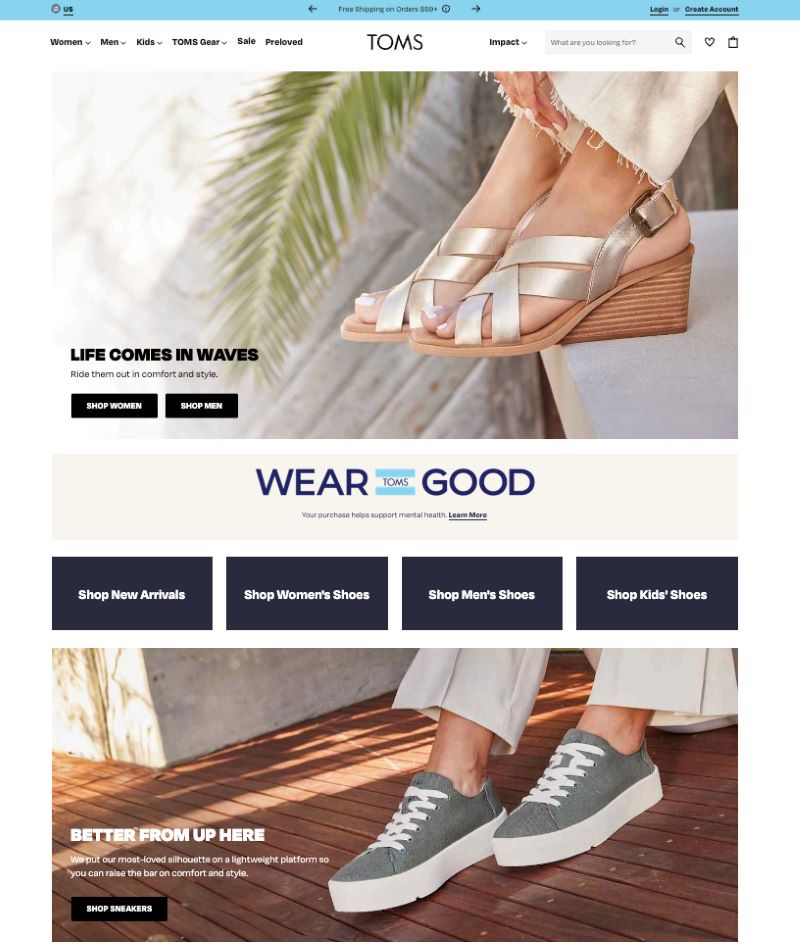The ecommerce industry is continually growing and changing, and, to stay competitive, retailers have to evolve with it. In this article, we have identified 16 of the top ecommerce trends for 2024, so that you can stay on top of the trend cycles and conquer the ecommerce landscape.
Keep reading to learn more about what the ecommerce industry looks like today, projections for the future, and actionable tips to help you capitalize on the top trends in ecommerce and put them into action.
1. Mcommerce Outpaces Desktop Use
Mobile commerce (mcommerce), or online shopping that takes place on a mobile device such as a smartphone or tablet, is rapidly growing, especially among younger shoppers. In fact, last year, mcommerce sales made up the majority (59%) of all ecommerce sales, hitting nearly $2.2 trillion globally. And, it doesn’t look like mcommerce is slowing down anytime soon. By 2027, experts expect mobile sales to reach $3.4 trillion and 62% of all ecommerce sales.

What You Can Do:
- Ensure your ecommerce website is mobile-ready, if not mobile-first. Using an ecommerce platform like BigCommerce or Shopify makes it easy to create a responsive, mobile-optimized experience for all online shoppers.
- Follow our recommended ecommerce website design principles when creating your online store.
- Ensure you have quality photos and informative product descriptions on your product detail pages.
Learn more about the mobile commerce landscape and how people are shopping online:
2. V-commerce Enhances the Online Shopping Journey
Virtual commerce (v-commerce) is online shopping technology that uses virtual reality (VR), augmented reality (AR) and artificial intelligence (AI) to provide shoppers with an immersive experience.
The most common application of virtual commerce is, “Try before you buy.” This is where 3D mapping enables customers to try products or preview experiences before buying them, creating more shopper assurance. You may have used the technology yourself on sites like Ray-Ban.

Ray-Ban introduced virtual try-ons, where customers can see what glasses will look like on their unique faces. (Source: Digital Trends)
While there is often a level of consumer distrust when new technologies come on to the scene, v-commerce has been received very positively. A commonly cited Deloitte study found that 71% of consumers would shop more if a business used AR technologies. Not only that, brands with AR/VR content have shown a 94% higher conversion rate compared to brands that don’t offer the tech.
What You Can Do:
- Invest in AR/VR features such as virtual fitting rooms.
- Create filters in social media such as Instagram, TikTok, and Snapchat that employ using products to help consumers “see” how your products look on them.
3. Voice Search Is Gaining Popularity
The number of voice assistant users is set to grow to 157.1 million by 2026, representing nearly half of the population. Along with the adoption of the technology for facilitating everyday life, voice assistant technology is being used to shop online. According to data from Coupon Follow, 47% of shoppers use voice commands to do online shopping and 58% of them are satisfied with their experience.
What You Can Do:
- Optimize your ecommerce SEO for semantic use. This means building more human-focused meaning and depth into your content with techniques like including synonyms and related words along with more conversational product names and descriptions.
- Prioritize creating engaging features for your store, such as product and review videos as well as a smooth buying experience. Remember, voice assistants typically crawl Google to generate customer suggestions, so it’s crucial to appeal to shoppers and search engines alike.
4. Social Commerce Continues to Be a Major Force
In 2023, the global social commerce market value was $913.90 billion and it is set to continue to grow at a compound annual growth rate of 31.6% from 2023 to 2030. This isn’t surprising, considering younger generations are already making online purchases via social media and are going to continue to increase their buying power in the years to come.
If the sheer size of the social commerce market hasn’t convinced you to get your business on to social platforms, consider these facts: 77% of consumers prioritize brands with a social media presence, and 78% of Gen-Zers discover new brands or products via social media. Consider your increased reach and consumer trust, to name just a few of the benefits of selling your goods on social platforms.

Social commerce is a growing force in the ecommerce landscape. (Source: Paid)
What You Can Do:
- Meet your customers where they are. Identify which social platforms your target customers are more active and engaged in and focus your marketing efforts there.
- Enable in-app shopping for your social channels. Check out these guides to get started:
- Lure first-time buyers and window shoppers with an exclusive channel-specific discount or limited-time offer.
- Harness the power of social media advertising.
5. AI Is Improving Personalization
Artificial intelligence (AI) in retail helps brands collect consumer shopping data and map out the buying journey. The data AI collects typically pertains to how customers shop, their preferences when browsing, and the time of purchase. With this data, AI can offer more personalized shopping experiences and marketing outreach efforts—a key part of appealing to the modern consumer.
What You Can Do:
- Research, experiment, and pay attention to industry news, use cases, and available AI tools for ecommerce.
- Invest in solutions like an AI Assist feature that can build listening capabilities and identify emerging customer preferences.
- Personalize, personalize, personalize! Even without AI, you can personalize your customer’s online shopping experience by adding features in your ecommerce platform, such as product recommendations, offers, and discounts. Email marketing segmentation can also go a long way in personalization.
- Create an omnichannel experience for your customers. More than half of consumers look at a product online and buy in-store and vice versa. In today’s shopping landscape, it is imperative to give a seamless shopping experience for customers.
6. Privacy & Security Are Growing Priorities
While the majority of consumers are OK with brands using their personal information to create tailored content and offers, data privacy is still extremely important to them. According to data from the Boston Consulting Group, most people want a more personalized online experience, but 45% are uncomfortable sharing their data to create personalized ads.
This leaves retailers in a tough position. You need data to deliver the personalized experience that consumers want, but collecting that data can cause distrust and even legal issues. So, what can you do? According to BCG’s survey, consumers want to know three main things:
- What data is being collected?
- Why is it being collected? Or, what will it be used for?
- How is it being collected?
If you can provide transparency, you will be able to avoid the pitfalls of gathering consumer data.
What You Can Do:
- Consider adopting zero-party data, which is information collected directly from relevant, consenting customers, and collect customer data in-house.
- Use quizzes, polls, and registration to collect zero-party data. Since they require a more participatory customer experience, zero-party data can also help you improve engagement.
- Implement security and privacy protocols for customer data protection and be transparent about how your brand collects, stores, and uses customer data.
7. Subscriptions Create Opportunities to Harness Loyalty
Offering subscriptions has become a trend for ecommerce businesses because it benefits both parties—convenience and rewards attract loyal customers, and ecommerce brands are guaranteed monthly sales. This is especially important in an age where browsing for alternate options and abstaining from brand loyalty is increasingly becoming the norm.
With ecommerce brands looking for new ways to harness brand loyalty, it is no surprise that the subscription market is forecast to grow at 71%, surging to more than $2 trillion by 2028.
What You Can Do:
- Create a loyalty program. You can get some ideas with our customer loyalty program ideas and examples.
- Ensure your loyalty program is included in your greater ecommerce marketing strategy.
- Churn rate (which measures the loss of customers over time) is the biggest challenge for subscriptions. Improve customer retention rates by offering special perks such as free delivery, lower prices, and access to limited products.
8. Sustainability Is a Consumer Priority
Sustainability is becoming increasingly important among shoppers. In fact, 58% of consumers are willing to pay more for sustainable products and nearly 80% of shoppers look at the sustainability of brands and their products when making purchases.
What You Can Do:
- Consider using more sustainable packaging solutions.
- Source more eco-friendly products or those that were made in your home country to avoid egregious emissions.
- Stay on top of retail sustainability trends.
9. Consumer Consciousness Is Rising
As the market becomes more saturated with brands, consumers are more discerning when it comes where to spend their money. One thing that helps them make decisions is when brands align with their value system. A study from Adobe and Wunderman found that 89% of shoppers are loyal to brands that share their values. Furthermore, three-quarters of shoppers will part ways with a brand over a conflict in values.
A great example of a retailer with a strong mission is TOMS, a shoe brand that sells canvas shoes. For each pair of shoes it sells, TOMS is committed to donating another pair to a child in need. Recently, TOMS also started donating one-third of its profits to grassroots operations in efforts to create more autonomy at a local level. TOMS’ moral stance has garnered the brand massive support and sets it apart in the industry.

The TOMS brand is all about its mission and making a positive impact. Its brand statement is, “We’re in the business to improve lives.”
What You Can Do:
- Showcase your brand values across your website and social channels. Ensure your messaging reflects your values and stays consistent throughout to create a strong brand image.
- Create values-centric content, especially in social media.
- Choose to work with people that have the same values, whether it be for collaboration or a retail promotion. Try running a promo in which you donate a portion of your sales to a charity that aligns with your values.
Read more: Ethical Consumerism for Retailers: The Ultimate Guide
10. Livestream Shopping Is the Latest Revolution
Livestream shopping or live commerce is when a brand showcases and sells its products over a livestream, typically on a shopping platform like Amazon, TikTok, or Facebook. While livestream shopping has been a major force in Asia for the last several years, it is just taking hold of western markets—and the new shopping medium has proven to be extremely successful.
Fifty-five percent of businesses have been using Facebook to livestream shopping events, with encouraging results. Nearly 60% of livestream viewers usually buy during or after the event.
Not only that, livestream events have seen 10x higher conversion rate than conventional ecommerce channels, with luxury goods seeing conversions as high as 70%.
What You Can Do:
- Get in on the trend by hosting your own livestream shopping events.
- Stay on top of livestreaming trends and learn more about the livestream industry so you can create a strong strategy.
11. Chatbots Improve the Online Shopping Experience
Chatbots are AI technology that are integrated into ecommerce sites as messaging services where consumers can get instant answers to questions about products, policies, orders, and more. While chatbots have not replaced human customer service, they have been proven to enhance the shopping experience. Forty-one percent of consumers prefer live chat over phone, email, and social media support because it offers immediate help with minimal effort.
What You Can Do:
- Implement chatbots in your website and social channels’ messaging platforms.
- Focus on improving conversion rates by refining chatbot responses to common conversational topics.
- Leverage AI and machine learning capabilities in your chatbots for personalized customer interaction. Be sure to look for AI-supported features when shopping for chatbot platform providers.
- Monitor and assess chatbot interactions regularly to continually refine and improve the user experience.
12. Hybrid Shopping Is the New Norm
Modern consumers expect a phygital shopping experience—a blend of online shopping and physical retail experiences. To accomplish this, ensure your ecommerce platform seamlessly integrates with multiple channels, including brick-and-mortar stores (if applicable) and various online platforms. This approach to hybrid commerce, often called omnichannel selling, has become the new standard in retail.
Let this fact motivate you: Shoppers tend to make additional purchases while picking up their items in-store, with 47% of online shoppers saying they always or often end up buying more products when picking up their orders in-store. Another 17% say they sometimes purchase additional items when picking up their orders in-store.
What You Can Do:
- Set up click-and-collect for your store.
- Establish sales channels on other platforms, such as social media (social commerce) and marketplaces. Use these guides to get started:
- Take advantage of showrooming and webrooming trends.
13. Shoppers Want Mobile Wallet Payment Options
Mobile or digital wallets are payment methods that are used virtually, typically accessed on one’s smartphone. ApplePay, Google Pay, and PayPal are some mobile payment options. In the last several years, mobile wallets have become increasingly popular for both in-person and online use.
In 2022, mobile payments were used for nearly half of all global ecommerce transactions and there are no signs of slowing. Additionally, offering mobile payment options for online transactions has been shown to boost conversion rates by up to 5%.
To capitalize on the potential benefits of offering mobile payment options and to stay up to date with the modern payments landscape, retailers should add as many mobile payment methods to their online checkout as they can.
What you can do:
- Opt for an ecommerce platform that incorporates mobile payment options into its checkout.
- Integrate PayPal, ApplePay, Google Pay, and Amazon Pay into your online checkout
14. Customer Financing Is Used for Purchases Large & Small
Customer financing or buy now, pay later (BNPL) services came on to the scene only a few years ago and, since their introduction, have become incredibly popular for purchases large and small. In fact, BNPL is outpacing credit card use, especially among younger generations. And, during the past holiday season, consumers spent more than $16 billion via BNPL services like AfterPay, Klarna, and PayPal. And, as with mobile wallets, offering a BNPL option can boost conversions by about 2%.
While you can expect to incur higher processing fees for BNPL transactions, offering the service is important for appealing to the modern consumer.
What you can do:
- Check out the different BNPL providers to determine which option will be best for your business.
- Integrate BNPL payment options into your online checkout.
- If you are a Square POS user, there is an Afterpay integration already available on your Square POS account—you simply have to toggle on the Afterpay option in your checkout settings to add it to your in-store and online checkout.
15. TikTok Shop Is Gaining Major Traction
The TikTok ban might be looming, but until it is passed, TikTok will likely remain an eminent force in the ecommerce landscape—and you should be capitalizing on its potential. While still in its early days, TikTok Shop has already proven to be an incredibly powerful force. It generated $363 million in US consumer spending in the third month since its North American launch, a 72% increase from its month prior.
As more and more major brands join TikTok Shop to sell their products, consumers will continue to spend more time and money on the platform. To increase your reach and harness the buying potential of TikTok Shop, it is key that your brand adds TikTok to your omnichannel sales strategy.
What you can do:
- Learn about selling on TikTok and TikTok Shop.
- Create a TikTok marketing strategy to promote your goods.
- Source and sell viral TikTok products to capitalize on trend cycles.
- Check out TikTok Shop statistics to see how it’s dominating the social commerce scene.
16. Deals Are More Important Than Ever
Over the past several years, the economy has been rocky and uncertain. In response, many consumers are looking to save money by seeking out deals and discounts wherever they can. According to a 2023 survey from Klavijo, deals and discounts are top drivers for both goods and services spending.
While you don’t want to sacrifice your margins too severely, it is important to offer discounts wherever you can to appeal to the price-conscious consumer.
What you can do:
- Devise a pricing strategy that both maintains your margins and offers a sense of value to your shoppers.
- Offer free shipping.
- Create a loyalty program that rewards shoppers with deals and discounts.
- Consider if you can make budget cuts so you can offer discounts without hurting your bottom line.
Frequently Asked Questions (FAQs)
Click through the questions below to get answers to some of your most frequently asked questions on top trends in ecommerce.
Ecommerce is continually evolving and growing. Among the trends that will shape the future of ecommerce and eventually become the new normal for the industry are mobile shopping, social commerce, AR and VR technologies, AI, personalization, voice searches, subscription models, and sustainability.
Yes, most definitely. US ecommerce sales surpassed $1 trillion for the first time in 2022, and Statista forecasts it will make up 24% of all retail sales worldwide by 2026, up from 18.8% in 2021. That’s equal to more than $8 trillion in expected ecommerce sales in 2026.
Today’s consumers are more discerning when it comes to buying online because they have access to more information. Ecommerce has also given them access to products from around the world. As such, they are now more demanding in terms of quality, service, sustainability, and brand values. Ecommerce continues to change toward personalization, and AI is helping online merchants analyze more data to market better.
Bottom Line
The world of ecommerce is ever-changing and you have to stay on top of its evolution if you want to stay competitive and capitalize on growth potential. The ecommerce trends outlined in this article should serve as a guide for your online business as you evaluate how you want to grow in the year to come. They should empower you to understand the ecommerce landscape so you can choose apt strategies and grow your ecommerce business and reap the rewards of a growth mindset.